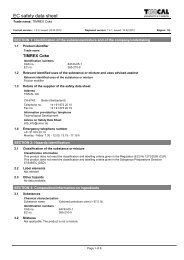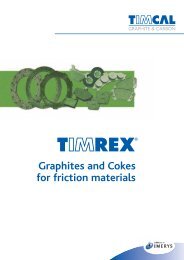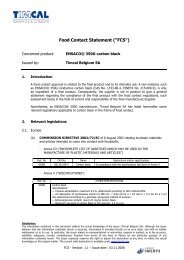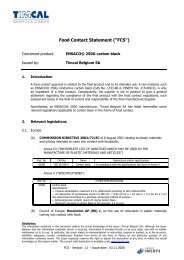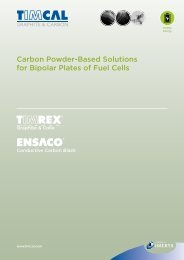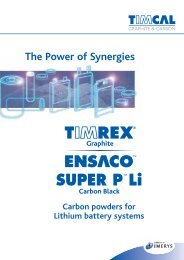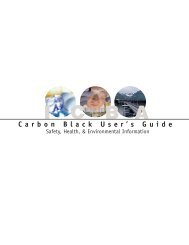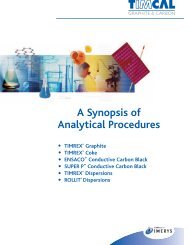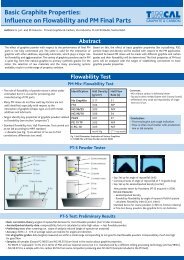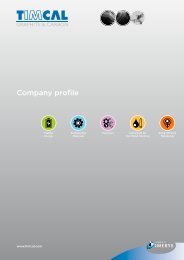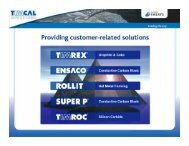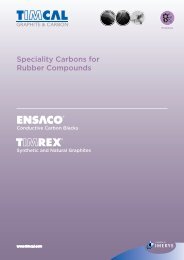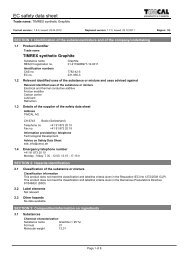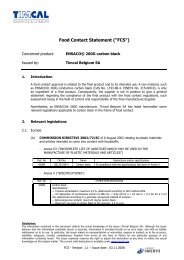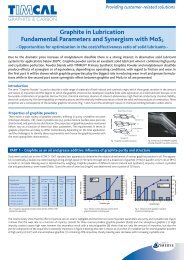ENSACO® Conductive Carbon Black for polymer ... - Timcal Graphite
ENSACO® Conductive Carbon Black for polymer ... - Timcal Graphite
ENSACO® Conductive Carbon Black for polymer ... - Timcal Graphite
Create successful ePaper yourself
Turn your PDF publications into a flip-book with our unique Google optimized e-Paper software.
Typical applications <strong>for</strong> TIMREX® <strong>Graphite</strong> and Coke<br />
Flame retardant<br />
<strong>polymer</strong>s<br />
What is expandable graphite<br />
and how does it work as flame retardant?<br />
NExpandable graphite (EG) (or graphite salt) is<br />
a halogen-free material consisting of graphite<br />
and acid. The acid is intercalated between the<br />
graphene layers. EG is manufactured by the<br />
oxidation of natural graphite in a strong acid<br />
such as sulphuric or nitric acid. After the reaction<br />
the graphite is washed in order to remove<br />
traces of acid left on the surface (typically the<br />
final pH of our TIMREX ® Flare Grades range<br />
from 4 to 8).<br />
Expansion Volume (ml/g)<br />
180.0<br />
160.0<br />
140.0<br />
120.0<br />
100.0<br />
80.0<br />
60.0<br />
40.0<br />
20.0<br />
NWhen expandable graphite is exposed to heat,<br />
it can expand to several hundred times its original<br />
volume, and covers the entire burning surface<br />
of the substrate with a “worm” like structure<br />
of expanded graphite. NThe char, <strong>for</strong>med by<br />
the expanded graphite, acts as an insulating<br />
agent and dramatically reduces the heat release,<br />
mass loss, smoke generation, and toxic gas emission<br />
of the substrate.<br />
TIMREX® Flare 100 Expansion behaviour vs Temperature<br />
0.0<br />
0 100 200 300 400 500 600 700<br />
Temperature (°C)<br />
Expansion behaviour<br />
of TIMREX ® Flare Grades<br />
The expansion volume of the graphite salt is<br />
a function of the temperature. The temperature,<br />
at which expansion begins, the so-called<br />
onset temperature, mainly depends on<br />
the type of acid (the graph shows the expansion<br />
behaviour vs temperature of TIMREX ®<br />
Flare 100). Particle size, carbon and acid<br />
content also affect the expansion. The bigger<br />
the particle size, the higher the expansion<br />
volume. The higher the carbon content or<br />
the acid contents the higher the expansion<br />
volume.<br />
Possible applications:<br />
PU foams;<br />
door & wall sealing;<br />
intumescent pipe wraps;<br />
rubber products;<br />
textiles, carpets and mats;<br />
coatings.<br />
Advantages:<br />
halogen free;<br />
environmental friendly;<br />
lower loading required compared to<br />
other mineral flame retardant materials;<br />
synergistic effect with other flame<br />
retardant materials.<br />
The in<strong>for</strong>mation contained in this brochure<br />
is believed to be correct. However, no warranty<br />
is made, either expressed or implied<br />
regarding the accuracy or the results to be<br />
obtained from the use of such in<strong>for</strong>mation.<br />
The user assumes all risk and liability <strong>for</strong><br />
loss, damage or injury to property or others<br />
resulting from the use of the material. No<br />
statement is intended or should be construed<br />
as recommendation to infringe any<br />
existing patent.<br />
23



